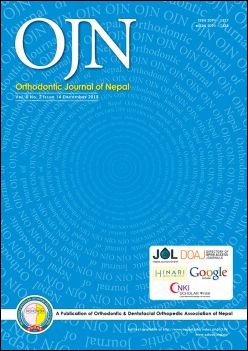Relationship between positive clinical VTO and post-treatment soft tissue profile following phase l growth modification therapy
DOI:
https://doi.org/10.3126/ojn.v8i2.23071Keywords:
Class II, Growth modification, Predication, VTOAbstract
Introduction: Facial profile improvement is goal of cotemporary orthodontics and a reason to seek orthodontic therapy. The soft tissue profile plays a important role on orthodontic diagnosis and treatment planning. The objective of this study is to investigate the relationship between positive clinical VTO and actual post-treatment soft tissue profile after phase l therapy of growth modification in Class II.
Materials & Method: Pretreatment simulation of post-treatment and actual post-treatment profile photographs of 30 class ll div l patients treated with twin block appliance were compared. Three profile photographs of each subject; pretreatment, positive clinical VTO and post-treatment were taken and on each photograph four angles; Nasofacial (NF), Nasomental (NM), Mentocervical (MC) and Nasolabial (NL) were drawn and measured. Mean, standard deviation, success and coefficient of determination of each angle was measured and linear regressions analysis was applied to find out the correlation.
Result: Nasolabial and nasomental angles showed greater success i.e. 81.4% and 68.1% respectively showing greater correlation, while nasofacial and mentocervical angles showed less success i.e. 48.1% and 48.3% respectively showing less correlation. Linear regression analysis revealed that positive clinical VTO significantly predicted post-treatment profile whereas coefficient of determination for nasomental and mentocervical angles was 76.5% and 60% representing a better goodness of fit while nasolabial and nasofacial angles was 53.6% and 51.6% demonstrating poor fit of regression lines.
Conclusion: Even though there is improved facial profile obtained by protracting the mandible into class l relation in a chair side maneuver in class ll div l malocclusions, yet the orthodontist should be tentative when predicting the outcome of growth modification to get benefit of this therapy.
Downloads
Downloads
Published
How to Cite
Issue
Section
License
Copyright © held by Orthodontic & Dentofacial Orthopedic Association of Nepal
- Copyright on any research article is transferred in full to the Orthodontic & Dentofacial Orthopedic Association of Nepal upon publication in the journal. The copyright transfer includes the right to reproduce and distribute the article in any form of reproduction (printing, electronic media or any other form).
- Articles in the Orthodontic Journal of Nepal are Open Access articles published under the Creative Commons CC BY License (https://creativecommons.org/licenses/by/4.0/)
- This license permits use, distribution and reproduction in any medium, provided the original work is properly cited.




